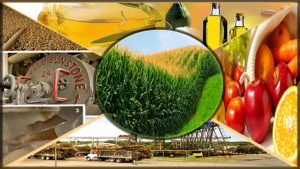 Soil tilth is a physical condition of the soil in relation to plant growth. It is the result of combined effects of soil texture, soil structure, and soil consistence. It depends not only upon the stability of soil structure but also on other soil properties, especially proper moisture conditions. For example, ploughing a fine-textured soil at the wrong moisture conditions may damage the soil structure and render the soil unsuitable for germination and emergence of seedlings.
Soil tilth is a physical condition of the soil in relation to plant growth. It is the result of combined effects of soil texture, soil structure, and soil consistence. It depends not only upon the stability of soil structure but also on other soil properties, especially proper moisture conditions. For example, ploughing a fine-textured soil at the wrong moisture conditions may damage the soil structure and render the soil unsuitable for germination and emergence of seedlings.
Tillage is a practice which is done to loosen the soil and produce a good physical condition. Traditionally, ploughing is done with different implements to prepare the seedbed for various crops. Tillage can have botb positive and negative effects.
Beneficial effects of tillage on soil structure. Tillage has several beneficial effects on soil structure.
(1) It loosens the soil, improving aeration and infiltration capacity, thus increasing the water-holding capacity of the soil and reducing runoff.
(2) Under dry soil conditions, tillage produces large clods that are baked in the sun. These clods break down subsequently under the effect of rain or irrigation thereby restoring the structure of compacted soils.
(3) Some tillage tools help inverting the soil. This is particularly desirable to bring well-structured, fertile soil to the top where the surface soil has lost its structure and nutrients. Inversion mixes different soil layers which improves the physical properties of the soil. It buries weed seeds below the germination depth and kills insect pests and pathogens.
However tillage also has its negative side.
Detrimental effects of tillage.
(1) Ploughing promotes good tilth only if it is done at the correct moisture content; otherwise cultivation at the wrong moisture content can he harmful to soil tilth.
(2) Frequent use of heavy machinery like cultivators and discs can cause mechanical breakdown of soil aggregates and make the soil surface compact. The total volume of pore space decreases and the bulk density increases. Some of the macropores spaces are reduced in size to micropores. The result is an increase in the volume of microporc space. The increase in microporc space in finetextured soil is detrimental because of reduced aeration and water movement.
(3) Another effect of cultivation is to expose organic matter to environmental factors and enhance its decomposition. This reduces the amount of organic matter available to act as a cementing agent for aggregation. This results in poor soil structure.
(4) Compacted soil layers formed due to the frequent use of a single ploughing tool or by working the soil under plastic conditions act as impermeable barriers to water movement. This type of compaction produces a layer with high bulk density at the hottom of the plough layer called a ploughsole or plough pan. Plough pans are a problem on sandy soils with insufficient clay content to cause enough shrinking and swelling with wetting and drying to naturally hreak up the compacted layer. Tillage to an appropriate depth can help to shatter these plough pans thus increasing the infiltration capacity and soil permeability.
Minimum tillage. To avoid the bad effects of tillage while retaining its benefits, the concept of minimum tillage or zero tillage is now advocated. Minimum tillage refers to a reduced number of tillage operations essential for seedbed preparation, while zero tillage means no tillage at all. In zero tillage, the erop is seeded directly into the soil without disturbing it. However, minimum or zero tillage practices increase the problem of weed control.
Key Refference : Soil Science By A. Rashid







